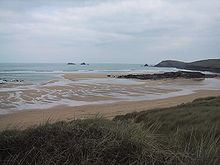- Constantine Bay
-
Coordinates: 50°31′49″N 5°00′45″W / 50.53036°N 5.01245°W
Constantine Bay is a village and beach on the Atlantic coast of north Cornwall, United Kingdom. It is situated approximately three miles (5 km) west of Padstow and is in the parish of St Merryn.[1] The beach is popular with surfers and has lifeguard patrols in the summer. Constantine Bay is named after Saint Constantine, a 6th century Cornish saint possibly identified with a minor British king Constantine. St Constantine's Well, an historic site, is accessible by public right of way on Trevose Golf Club's golf course. The area was a favourite holiday location of Margaret Thatcher during her premiership.[2]
Trevose Head and Constantine Bay SSSI is designated for both its biological and geological interests. The dune system at Constantine Bay is in an unfavourable declining condition because of the invasion by species such as bramble, ivy and sea buckthorn; and by visitor pressure causing erosion.[3]
Other coastal villages nearby include Harlyn, Porthcothan, Trevone and Treyarnon
References
- ^ Ordnance Survey: Landranger map sheet 200 Newquay & Bodmin ISBN 9780319229385
- ^ Brian Viner. "Cornwall Life: Padstow's meteoric rise". The Independent, 11 August 2004
- ^ "Condition of SSSI units". Natural England. http://www.sssi.naturalengland.org.uk/Special/sssi/reportAction.cfm?report=sdrt13&category=S&reference=1003038. Retrieved 1 November 2011.
External links
 Media related to Constantine Bay at Wikimedia Commons
Media related to Constantine Bay at Wikimedia CommonsGeography of Cornwall Cornwall Portal Unitary authorities Major settlements Bodmin • Bude • Callington • Camborne • Camelford • Falmouth • Fowey • Hayle • Helston • Launceston • Liskeard • Looe • Lostwithiel • Marazion • Newlyn • Newquay • Padstow • Par • Penryn • Penzance • Porthleven • Redruth • Saltash • St Austell • St Blazey • St Columb Major • St Ives • St Just-in-Penwith • St Mawes • Stratton • Torpoint • Truro • Wadebridge
See also: Civil parishes in CornwallRivers Topics History • Status debate • Flag • Culture • Places • People • The Duchy • Diocese • Politics • Hundreds/shires • Places of interest • full list...Sites of Special Scientific Interest in Cornwall and the Isles of Scilly - Annet
- Belowda Beacon
- Breney Common
- Crowhill Valley
- Cudden Point to Prussia Cove
- De Lank Quarries
- Dozmary Pool
- Draynes Wood
- Goonhilly Downs
- Goss and Tregoss Moors
- Gugh
- Loe Pool
- Lower Fal & Helford Intertidal
- Marazion Marsh
- Penlee Point
- Plymouth Sound, Shores and Cliffs
- Polyne Quarry
- Porthloo
- Roche Rock
- St. Michael's Mount
- Stepper Point
- Swanpool
- Sylvia's Meadow
- Talland Barton
- Tater–du
- Teän
- Tintagel
- Treen Cliff
- Trevose Head and Constantine Bay
- Upper Fal Estuary and Woods
- Upper Fowey Valley
Neighbouring areas: Sites of Special Scientific Interest in Devon · Sites of Special Scientific Interest in Somerset Categories:- Villages in Cornwall
- Beaches of Cornwall
- Bays of Cornwall
- Populated coastal places in Cornwall
- Cornwall geography stubs
Wikimedia Foundation. 2010.


